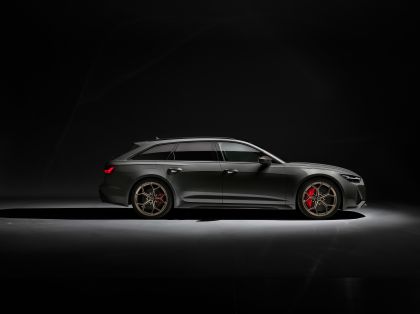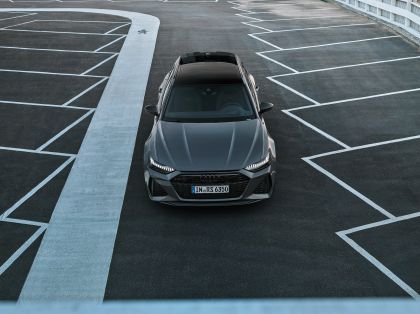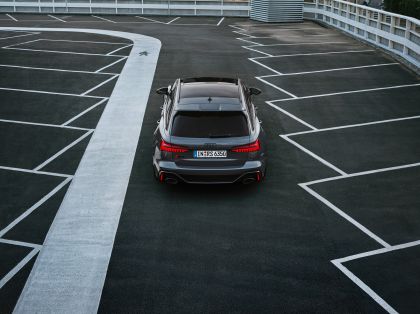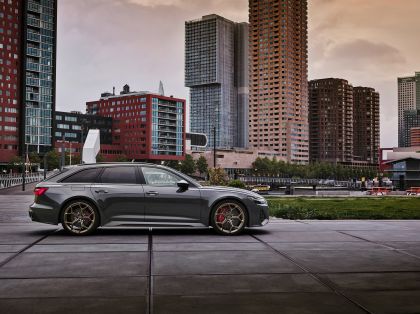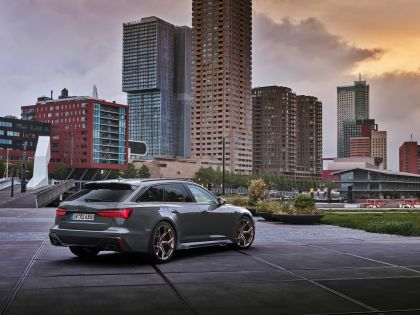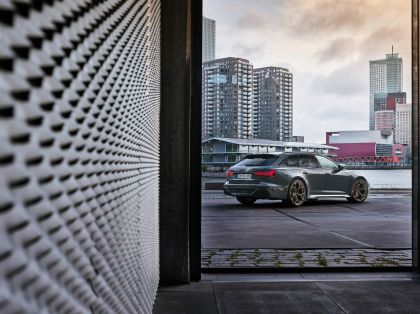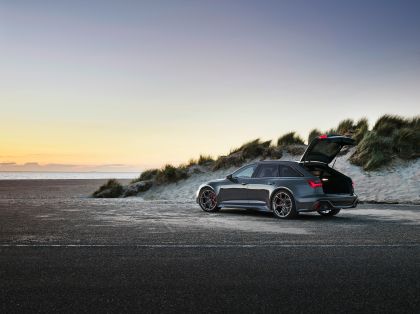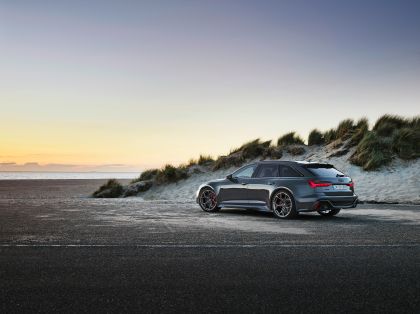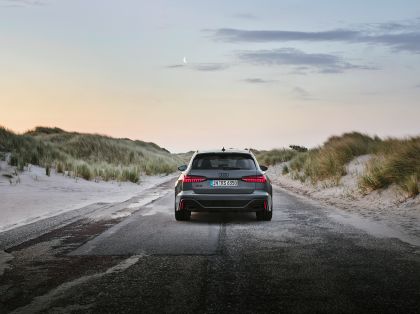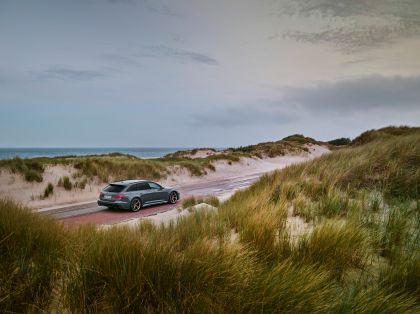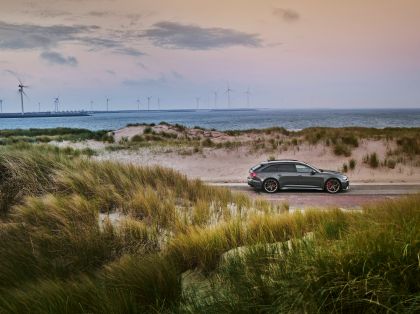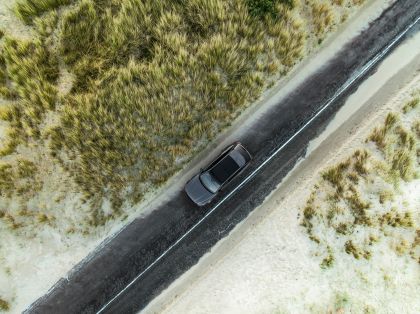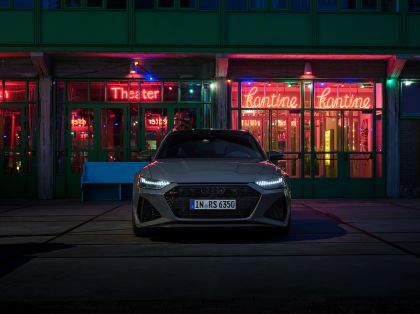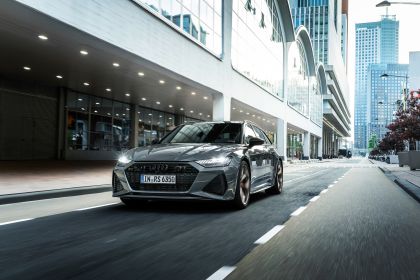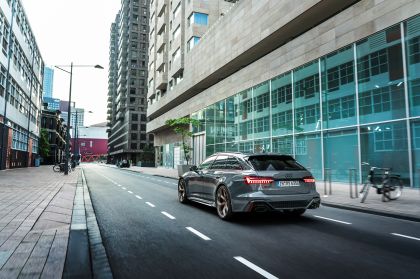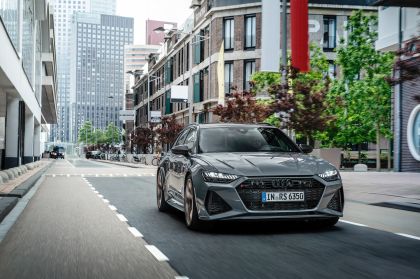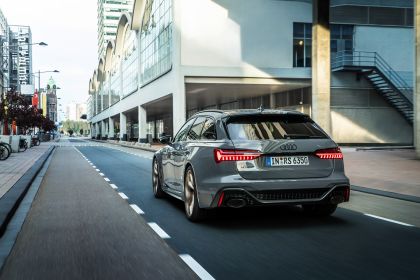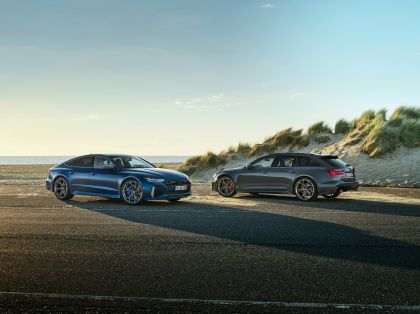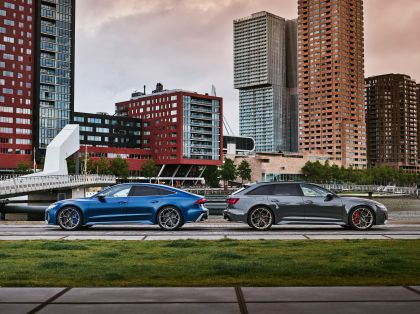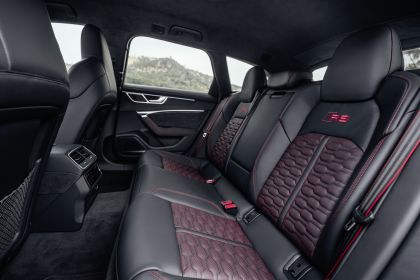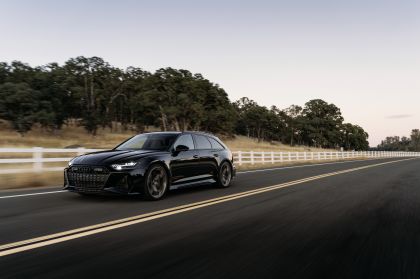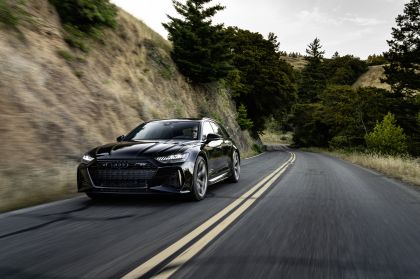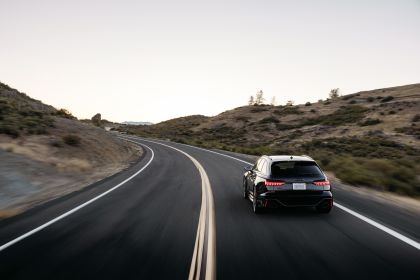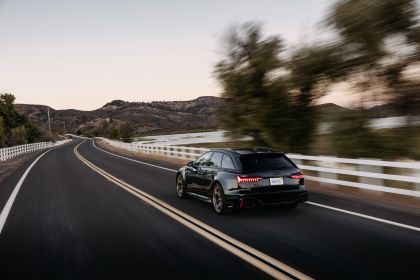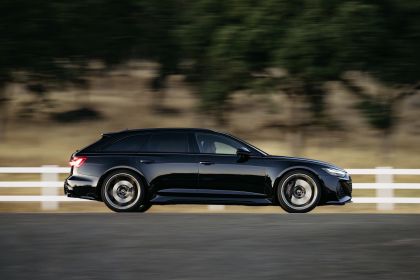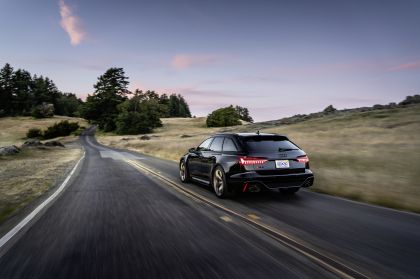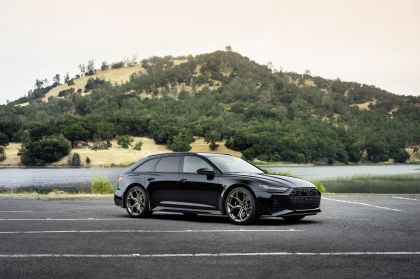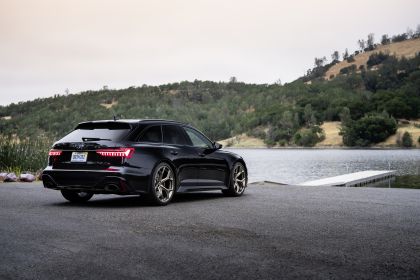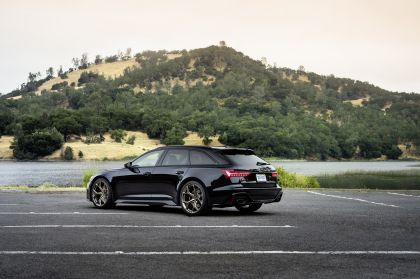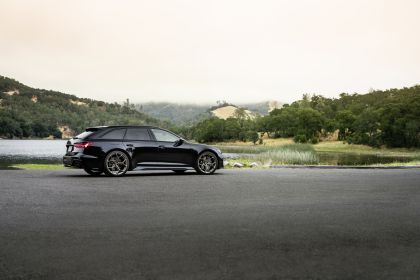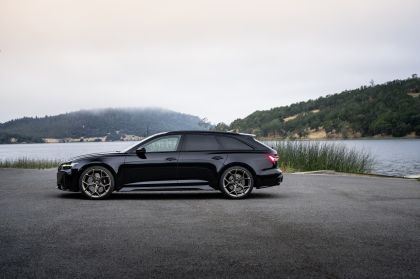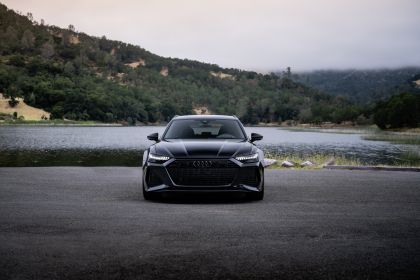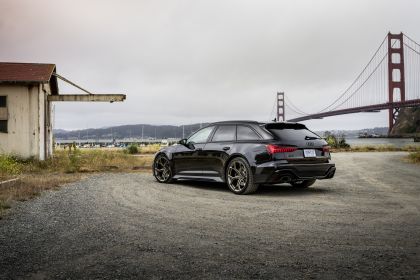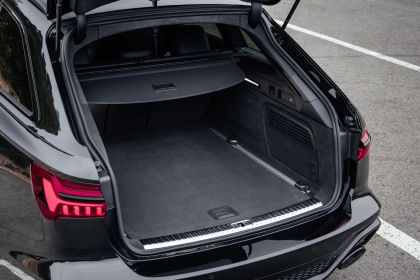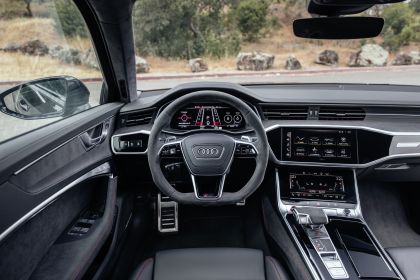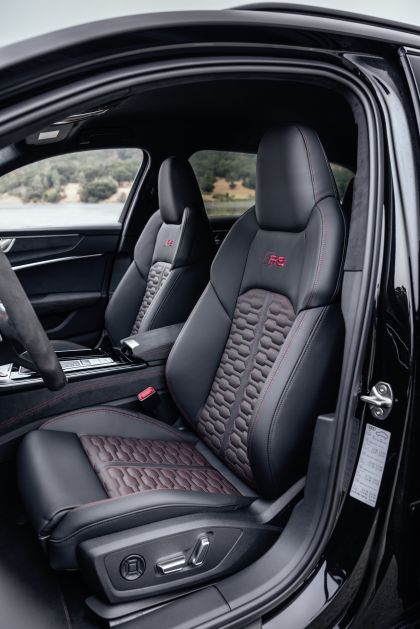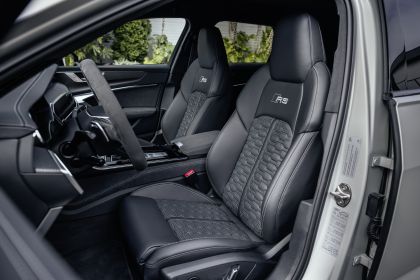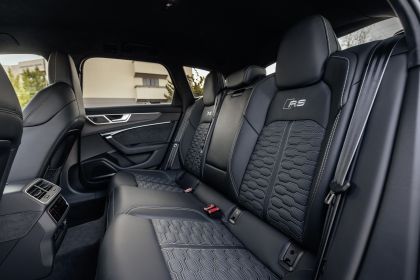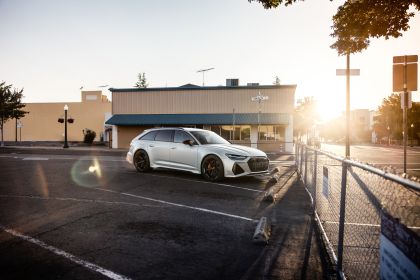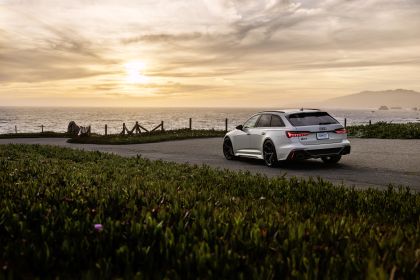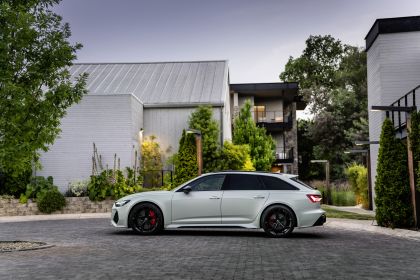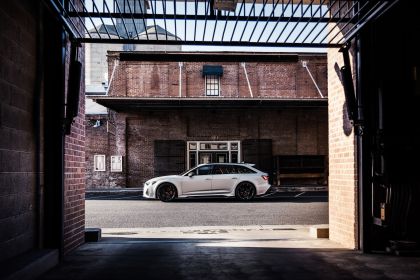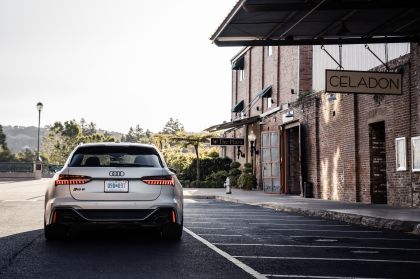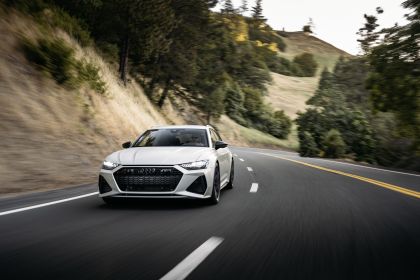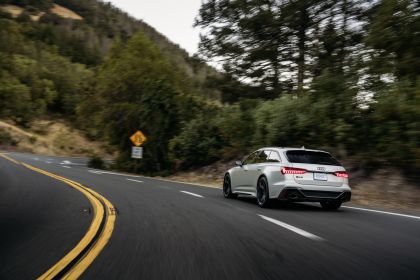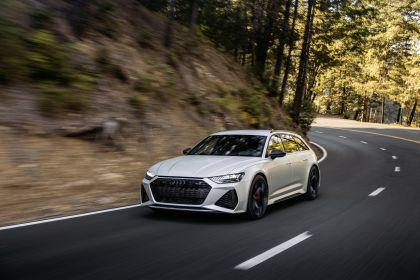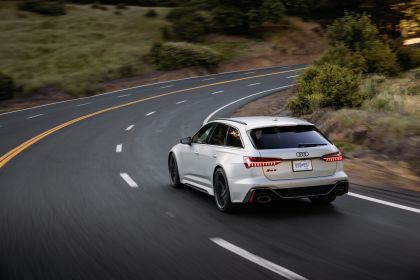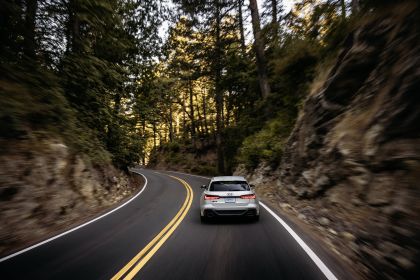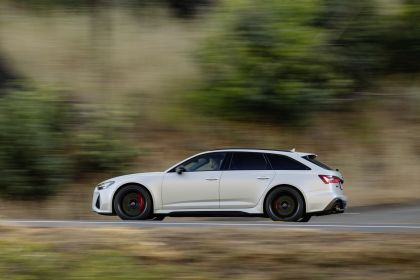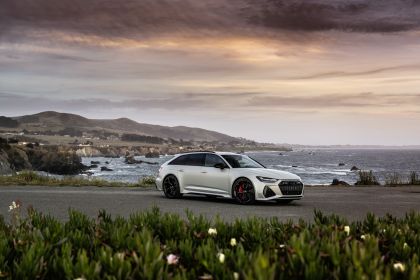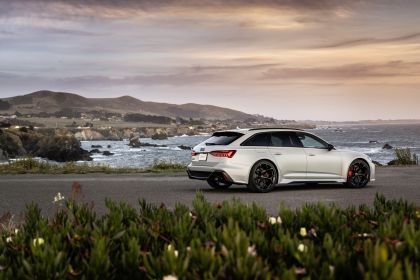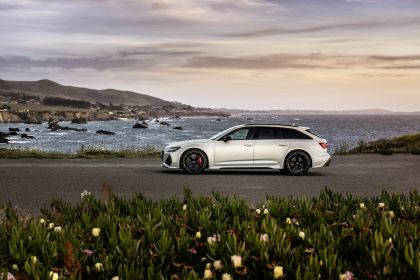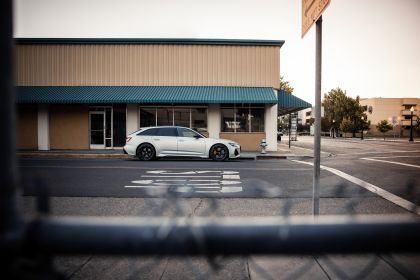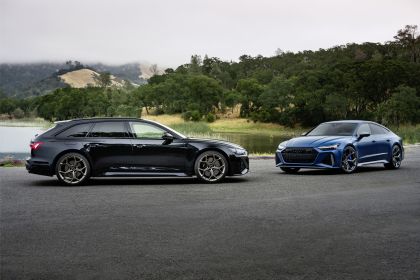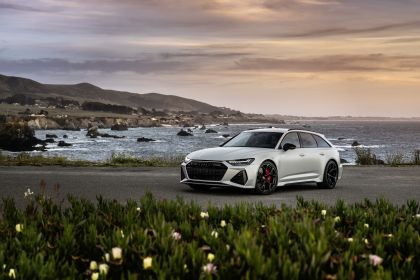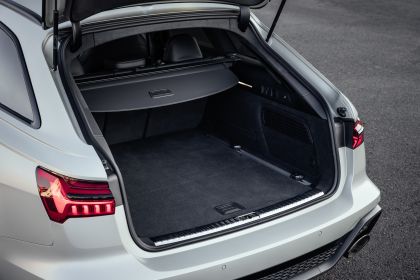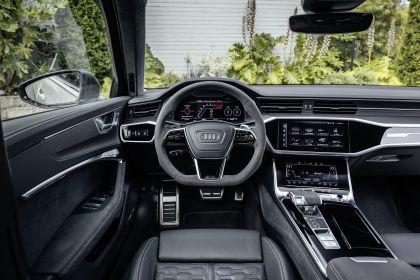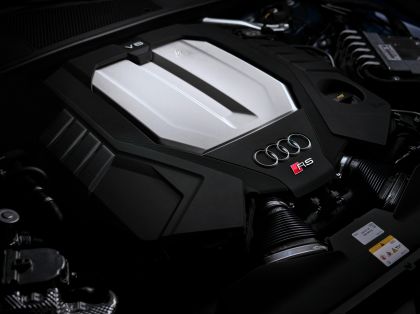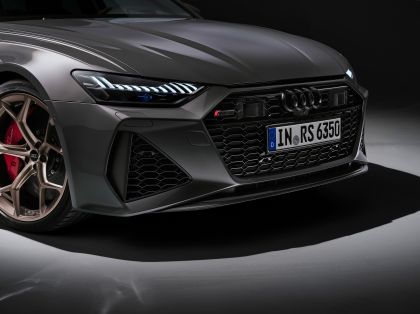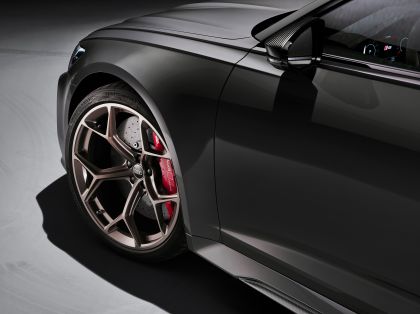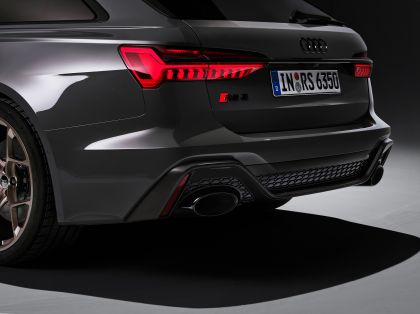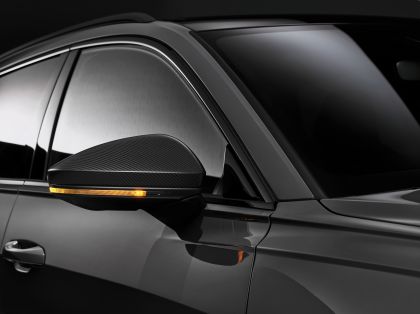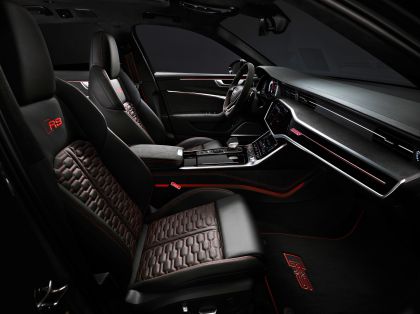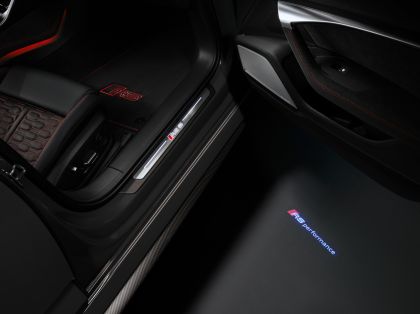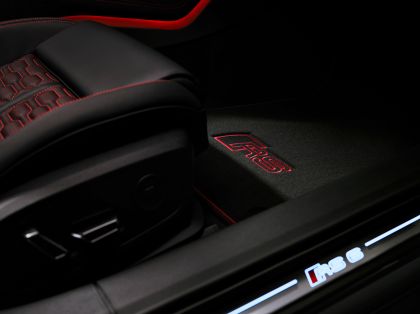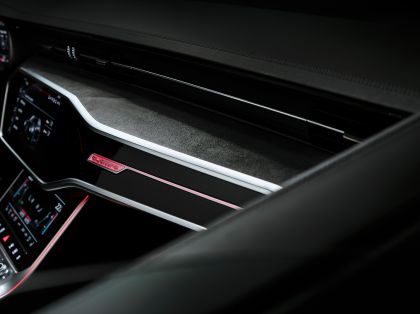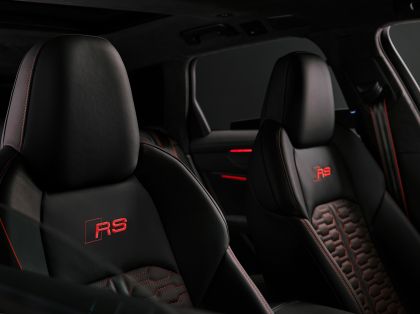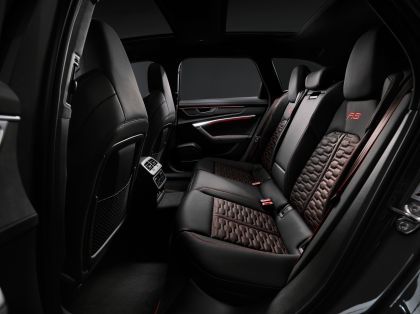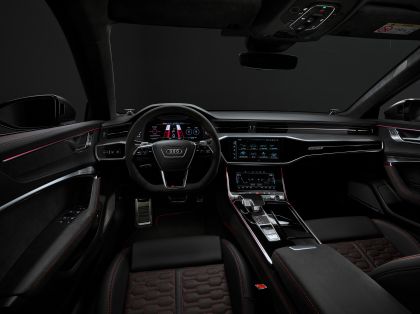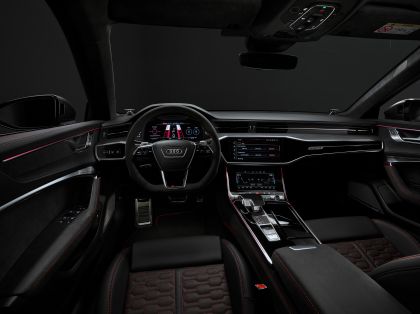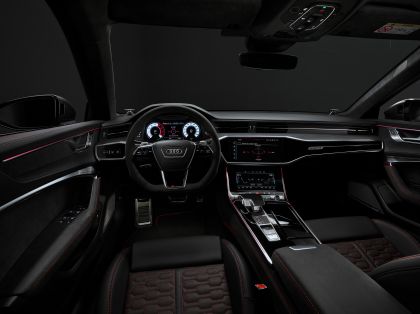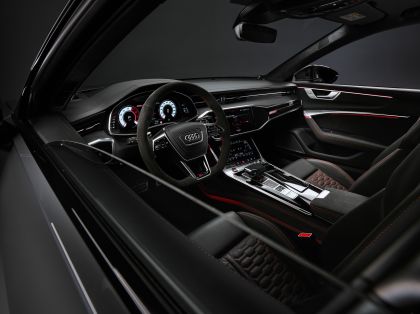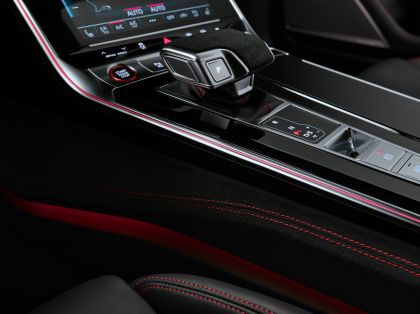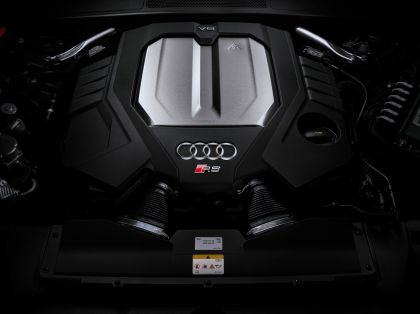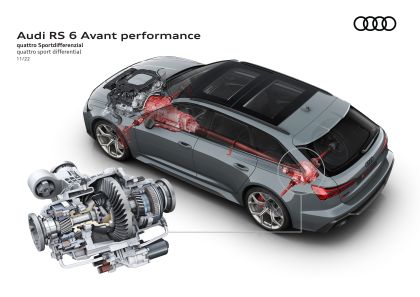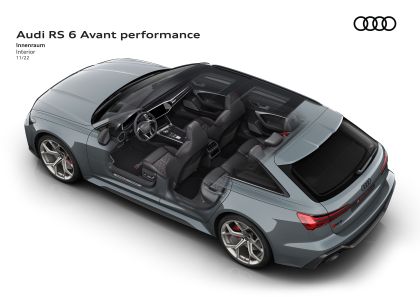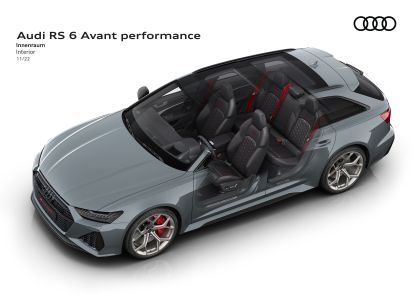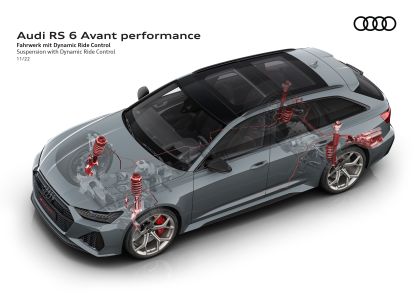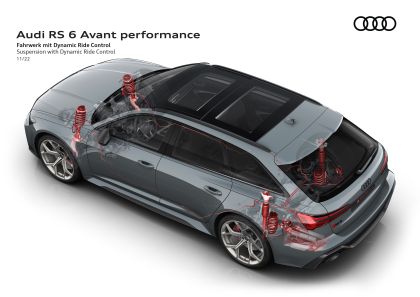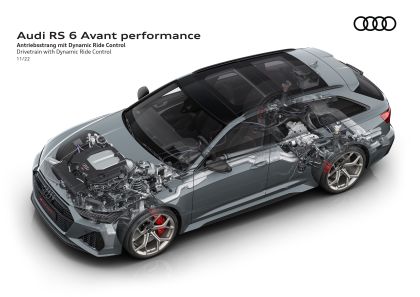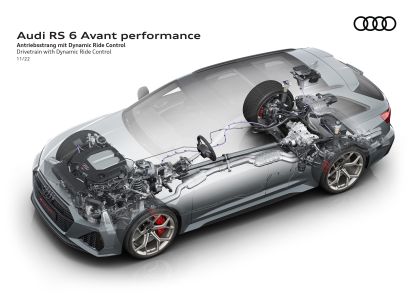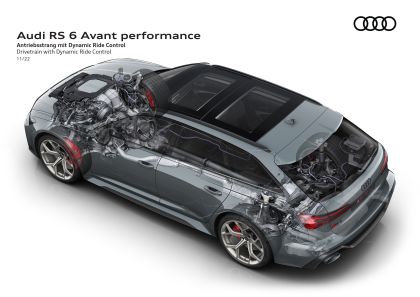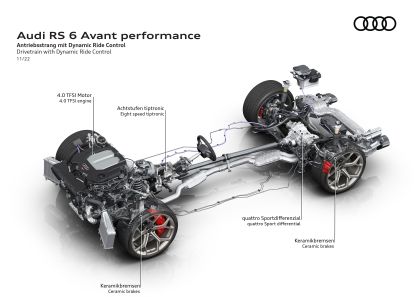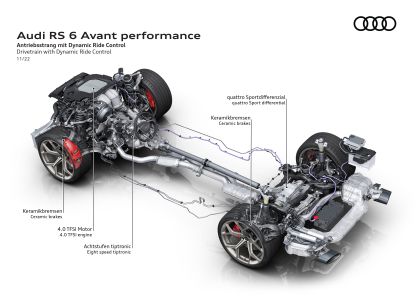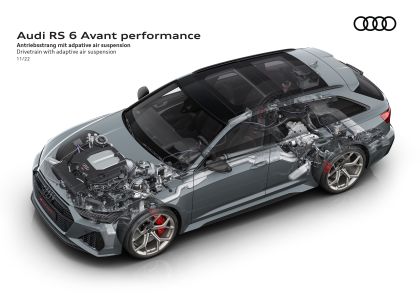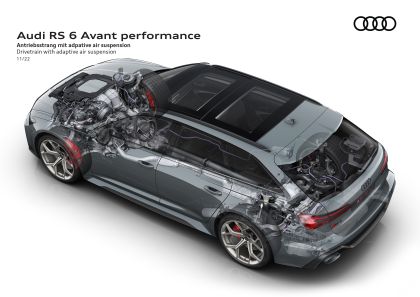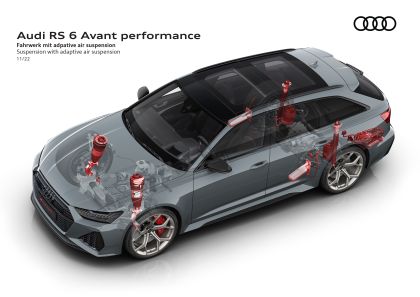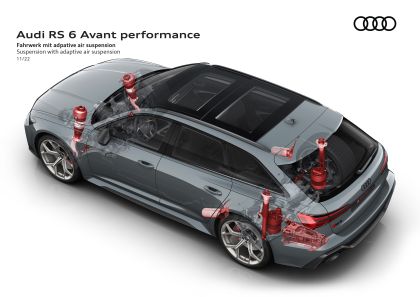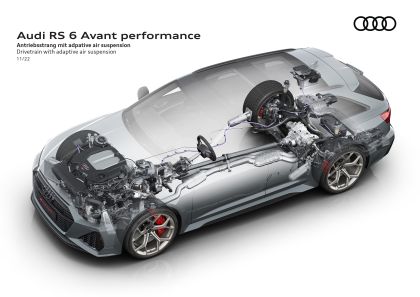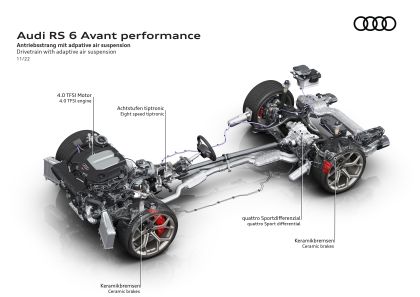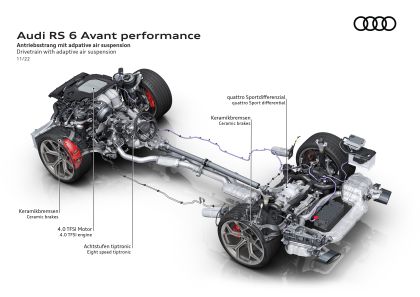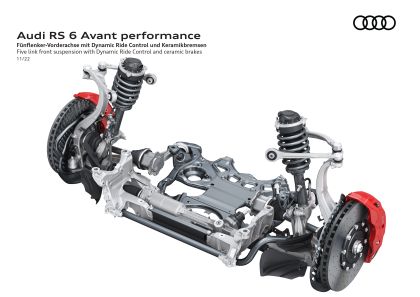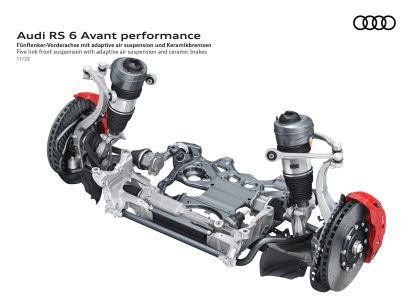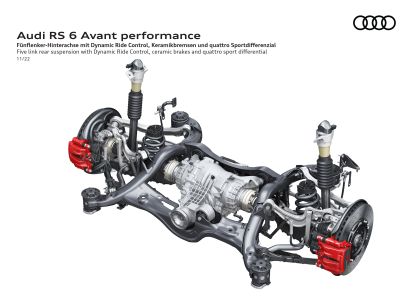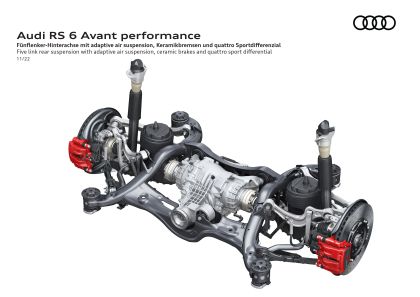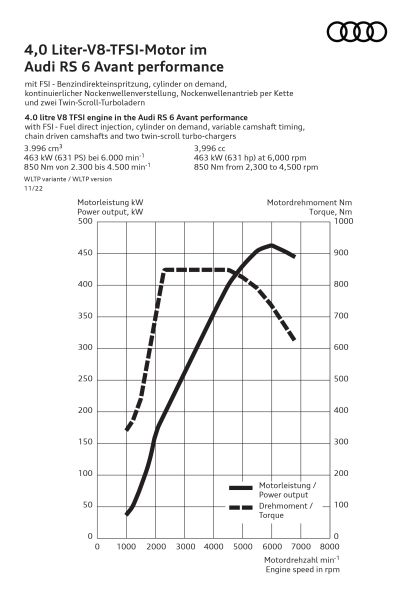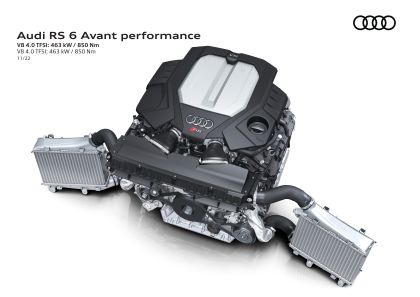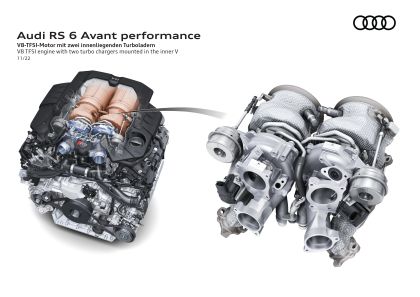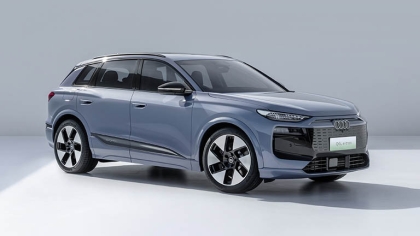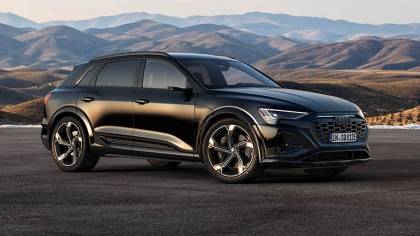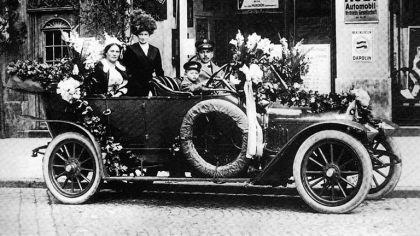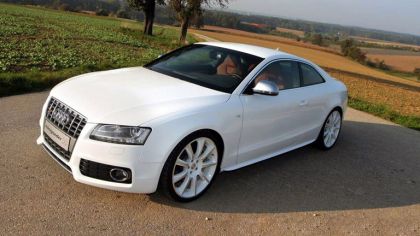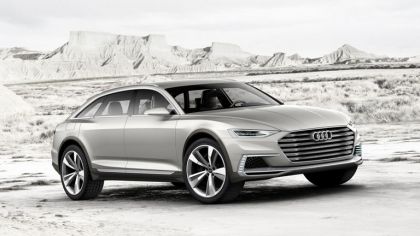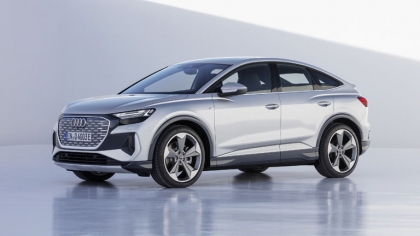More powerful and faster than any RS6 to date, the new Audi RS6 Avant performance is bursting with extras that sharpen the models' appearance and make for a more emotive driving experience. The potent 4.0-liter V8 biturbo TFSI engine now has an engine power of 463 kW (630 PS) and a maximum torque of 850 Nm.
At Audi, "performance" means more power. Larger turbochargers and an increase in boost pressure from 2.4 to 2.6 bar in the 4.0-liter V8 biturbo TFSI engine of the Audi RS6 Avant performance allow an increase of 30 PS in engine power and 50 Nm more torque compared to the base version. This means total power rises from 441 kW (600 PS) to 463 kW (630 PS) and maximum torque rises from 800 to 850 Nm (590 to 627 lb-ft). The performance model sprint from 0 to 100 km/h (0 to 62.1 mph) in 3.4 seconds, 0.2 seconds faster than the RS6 base version.
Less is sometimes more: Reduced insulation between the engine compartment, the interior, and the rear of the vehicle ensures the RS6 Avant performance will thrill customers with an exciting, next-level sound experience - the reduction also makes the car eight kilograms (17.6 lbs) lighter. The RS6 Avant performance has a total unladen weight of 2,090 kg (4,608 lbs).
For heightened driving dynamics: New self-locking center differential
Power from the 4.0 TFSI engine flows through a standard eight-speed tiptronic with faster shifting times to the quattro permanent all-wheel drive system.
The mechanical center differential distributes engine power to the rear axle at ratio of 40 : 60, and if slippage occurs, more torque is automatically applied to the axle with better traction - up to 70 percent can flow to the front axle and up to 85 percent to the rear axle. The self-locking center differential is lighter and more compact, improving driving dynamics as well as offering noticeably more precise cornering, which makes for less understeering at the handling limits. As an added improvement, the steering response is more exact with passengers benefitting from a more agile driving experience overall.
Exclusive and performing: 22-inch wheels with high-performance tires
The new Audi RS6 Avant performance roll off the line on standard 21-inch aluminum cast wheels in a ten-spoke star design and 275/35 tires. Besides 22-inch cast aluminum wheels, 22-inch lightweight wheels are also available for an even sportier look - in burnished glossy metallic black, matte gray, matte black, or matte neodymium gold. Inspired by motorsport, the airy 5-Y spoke design aids brake cooling and the lighter rims are manufactured in a high-tech forging-milling process. The new lightweight wheel is around five kilograms (11 lbs) lighter than the 22-inch aluminum wheel on the current RS6 Avant - this 20-kilogram (44 lbs) weight reduction in unsprung masses improves the throttle response.
New high-performance Continental "Sport Contact 7" 285/30 tires, which are part of the new lightweight wheel, play a key role in reducing weight. The tires offer consistently better grip on both dry and wet roads and reduce understeering when cornering at speed, making for overall more precise handling across the entire speed range. Additionally, the brake path is up to two meters shorter with the new wheels when braking from 100 to 0 km/h (62.1 to 0 mph).
The Audi drive select dynamic handling system lets the driver control the vehicle's character. Six profiles are available: efficiency, comfort, auto, dynamic, as well as two customizable RS-specific RS1 and RS2 modes.
But experience of the driving modes in the performance model is much more unique. For example, the coasting mode now only activates automatically in the efficiency profile, which means in speed ranges up to 160 km/h (99.4 mph), it switches off the combustion engine and coasts with no fuel consumption or drag torque from the engine. Additionally, fine-tuning to the engine control unit software makes for tighter load changes in S mode when the dynamic drive select mode or driving mode S is active, further heightening driving emotion. The updated software in the transmission control unit makes for faster shifting times and a noticeably increased spread between the various driving modes.
RS Dynamic Package as standard
The RS Dynamic Package is standard equipment in the RS6 performance model. This includes the increase in maximum speed to 280 km/h (174 mph), dynamic all-wheel steering (the RS-specific software update helps the driver with active steering corrections on the front and rear axles), and the quattro sport differential on the rear axle.
The RS Dynamics Package plus is also available as an option, which, in addition to the RS Dynamics Package, raises the top speed to 305 km/h (189.5 mph) and includes an RS ceramic brake system. Customers can order the calipers in gray, red, or blue and discs measure 440 mm (17.3 in) at the front and 370 mm (14.6 in) at the rear. The RS ceramic brake system weights a total of approx. 34 kg (75.0 lbs) less than its steel counterpart for a reduction of the unsprung masses.
For a grand entrance: fresh exterior colors and styling packages
The new RS6 Avant performance is available in a total of 16 exterior colors - for the first time, metallic and matte Ascari Blue and matte Dew Silver are included. The performance models stand out with standard RS exterior components in matte gray, including the exterior mirrors, the front spoiler, the front side flaps, the side sill inserts, the roof rails, and the trim on the side windows and rear diffuser. A matte carbon/black styling package is also an option, in which the roof rails and trim on the side windows are black. The Audi rings and model name is available in the customer's choice of chrome or black.
Out of the blue: new interior accents and features
In the interior, the lineup of familiar RS design packages in gray and red has been expanded to include blue. The steering wheel rim in Alcantra black features contrasting stitching in Mercato blue, whilst the floor mats, the side of the center console, and the selector lever cuff also come with blue contrasting stitching. The seat belts are full-surface ocean blue with the decorative inlays in a carbon twill structure with optional blue accents. The selector lever knob and the side of the center console are made with Dinamica microfiber, which consists of around 45 percent recycled PET fibers and the sports seats feature high-quality Valcona leather upholstery perforated with honeycomb stitching with contrasting stitching in Mercato blue. Another distinguishing feature is an entrance LED in the front doors that projects the lettering "RS performance" onto the ground next to the car.
Customers can order RS design packages in the three available color variants with optional additional features: decorative inlays, door armrests and center armrest in Dinamica microfiber. An added benefit of this equipment variant is the seat center panel with a gray, red, or blue inlay, while the customer's chosen color shows through in the perforated sports seats and the seat backs feature RS embossing in matching colors. Customers can use the new "Audi Exclusive Customizer" visualization tool to design their vehicles in thousands of individual combinations and thus create their own personal special edition.
They can choose from a wide range of individual paint finishes as well as leather and stitching colors; the tool uses a 3D model to visualize the customization process. Check out the configurator here.
The displays of the standard 12.3-inch Audi virtual cockpit plus offer new features including a blinking shift indicator in manual transmission mode which changes the RPM display from green to yellow to red, blinking in a manner identical to that used in motorsport, to indicate the optimal time to change gears. Then there is Launch Control, which fully exploits the acceleration potential of the Audi RS6 Avant performance by signaling the ideal moment to accelerate off the line, with new traffic light icons.
Engine
The twin-turbo V8 delivers 441 kW (600 PS) and provides a constant 800 Nm (590.0 lb-ft) of torque within a wide engine speed range from 2,050 to 4,500 rpm. The high-performance Avant takes just 3.6 seconds to complete the sprint from zero to 100 km/h (62.1 mph). And in a mere 12 seconds, the RS6 Avant reaches 200 km/h (124.3 mph). The top speed is electronically limited to 250 km/h (155.3 mph); this can be increased to 280 km/h (174 mph) with the dynamic package and even to 305 km/h (189.5 mph) with the dynamic plus package.
Larger turbochargers and an increase in boost pressure from 2.4 to 2.6 bar in the 4.0-liter V8 biturbo TFSI engine that the Audi RS6 Avant performance boast, allow an increase of 30 PS in engine power and 50 Nm more torque compared to the base versions.
This means a total increase in power from 441 kW (600 PS) to 463 kW (630 PS) and in maximum torque from 800 to 850 Nm. The performance model sprint from 0 to 100 km/h in 3.4 seconds, 0.2 seconds faster than the RS6 base version.
The twin-turbo V8 engine has a conventional 90-degree bank angle and a displacement of 3,996 cc (bore x stroke: 86.0 x 86.0 millimeters (3.4 in x 3.4 in)). Its crankcase is made of cast aluminum and weighs just 39.1 kilograms (86.2 lb). The cylinder linings have been machined with the aid of atmospheric plasma spraying. This method involves applying an extremely thin iron coating to the cylinder linings. These coated cylinder linings improve heat dissipation, thermal and mechanical resilience, and wear resistance. They also reduce internal friction significantly and ensure minimum oil consumption. An electronic valve located centrally in the inside V also regulates the map-controlled piston spray nozzles as required for piston cooling. This decreases the power requirements of the oil pump.
A fully variable pump drives the oil circuit. It is split into two separate oil galleries - one for the engine block and one for the cylinder heads. This layout ensures a reliable supply of oil even under the extreme lateral and longitudinal acceleration that the Audi RS6 Avant and the RS6 Avant performance is capable of achieving. The switchable water pump is only engaged from a temperature of 80 degrees Celsius (176 °F), as the coolant, which is stagnant at first, heats up more quickly and the engine reaches its operating temperature sooner. The chains of the valve gear are driven by a geared intermediate shaft. This also drives the water pump. To ensure that the cylinders are filled optimally, intake and exhaust camshafts can be adjusted by 50 degrees. Each cylinder bank drives a high-pressure fuel pump that builds up pressure of up to 250 bar. The injectors, located in the center of the combustion chamber, inject the fuel through seven holes, following special injection strategies depending on the requirements, from cold start to full load. The firing order is the same as that of the predecessor engine: 1-3-7-2-6-5-4-8.
The 4.0 TFSI produces a full-bodied and sporty V8 sound. The driver can influence the full sound of the power unit using the Audi drive select dynamic handling system. The Audi drive select system influences the engine and transmission management, the power steering, the suspension, the dynamic all-wheel steering, the quattro sport differential, the engine sound, and the way in which the automatic air conditioning works. The optional RS sport exhaust system with black tailpipe trim provides an even fuller sound. In the customizable RS1 and RS2 modes, customers decide themselves whether the four-liter engine should sound sporty or balanced.
Forceful: two twin-scroll turbochargers
The powerful torque that the 4.0 TFSI builds up even at slow speeds is mainly owed to the two twin-scroll turbochargers. In addition to elevated boost pressure, the diameter of the compressor wheel of the turbochargers has been increased by three millimeters (0.1 in). Each turbo supplies one cylinder bank with up to 1.4 bar of boost pressure (relative). This is 0.2 bar more than the predecessor. The increased boost pressure allows more air into the combustion chamber for the fuel combustion, which improves the fill level of the cylinders. This results in higher engine power and improved efficiency.
The cylinder heads have the intake side on the outside and the exhaust side on the inside. This allows the larger turbos and their optimized air-to-air intercooler to be located in the 90-degree inside V of the cylinder banks rather than in the usual location outside the side of the engine. This layout enables short gas flow paths with minimal flow losses and spontaneous engine response. Elaborate and effective insulation of hot components ensures thermally stable conditions in the inside V. The compression ratio is 10.1 : 1 for the RS6 Avant and 9.7 : 1 for the RS6 Avant performance.
Efficient systems: MHEV and cylinder on demand (COD)
Thanks to its mild hybrid system (MHEV) with a 48-volt main on-board electrical system, the 4.0 TFSI combines maximum performance with high efficiency. The heart of this system, the belt alternator starter, can recover up to 12 kW of power under gentle acceleration and feed it into a lithium-ion battery as energy.
If the driver releases the accelerator at a speed between 55 and 160 km/h (34.2 to 99.4 mph), the drive management will select one of two options. Depending on the driving situation and the settings in the Audi drive select dynamic handling system, the RS6 Avant and RS6 Avant performance recovers, i.e. the alternator converts kinetic energy into electric energy so that it decelerates, or it coasts with the engine switched off. Pressing the accelerator makes the belt alternator starter restart the engine.
MHEV technology allows for start/stop operation even in all ranges below a residual speed of 22 km/h (13.7 mph). Fuel savings of up to 0.8 liters per 100 kilometers are possible in everyday driving.
The cylinder on demand (COD) system is another measure onboard the vehicle that benefits efficiency. In higher gears at low to medium loads and engine speeds, it will switch off cylinders 2, 3, 5, and 8 by halting injection and ignition and closing the intake and exhaust valves. Due to the four-cylinder operation, the operating points in the active cylinders are displaced toward higher loads in areas of the characteristic map with higher efficiency, while the deactivated cylinders largely run without losses, like gas springs. When the driver presses the accelerator pedal, they are reactivated instantly. Each switchover takes mere milliseconds and is virtually undetectable by the driver and passengers.
Transmission
The power produced by the 4.0 TFSI is delivered via the standard eight-speed tiptronic transmission with optimized gear changing to the quattro permanent all-wheel drive system. A purely mechanical center differential distributes the forces to the front axle and rear axle at a ratio of 40 : 60. In the event of slip, more drive torque automatically goes to the axle with the better traction. Up to 70 percent can be directed to the front wheels, or up to 85 percent to the rear wheels.
The agile and reliable handling of the RS6 Avant and RS6 Avant performance is optimized by the wheel-selective torque control, which applies slight braking pressure to the wheels on the inside of the curve before they slip. This guides the torque to the wheel on the opposite side. In the optional RS dynamic package and RS dynamic package plus, Audi combines wheel-selective torque control with the quattro sport differential. The software of the sport differential calculates the ideal distribution of torque at the rear axle in terms of the vehicle dynamics continuously and thereby increases vehicle dynamics, traction, and stability. The sport differential features a conventional rear differential on both sides supplemented by a superimposed stage. It comprises two sun gears and an internal gear and rotates roughly ten percent faster than the drive shaft.
A multi-plate clutch in an oil bath and operated by an electrohydraulic actuator provides the power connection between the shaft and the superposition gear. When the clutch closes, it steplessly forces the higher speed of the superposition stage on the gear. Being forced to turn faster results in the additional torque required being drawn off from the opposing wheel on the inside of the curve via the differential. In this way nearly all of the torque can be directed to one wheel. The sport differential can distribute the torque between the left and right rear wheels in all operating states, including overrun. When turning or accelerating in a curve, they are predominantly steered toward the wheel on the outside of the curve - the car is literally pressed into the curve, counteracting even any hint of understeer. In case of oversteer, the sport differential stabilizes the vehicle by shifting torque to the wheel on the inside of the curve.
In the RS6 Avant and RS6 Avant performance all suspension components are actuated via the electronic chassis platform. The electronic chassis platform (ECP), which is installed in many Audi models with a longitudinal engine, is the central control unit for the suspension. To do this, it takes into account the speed, yaw rate, lateral acceleration, roll and pitching movements of the vehicle, the steering angle, coefficient of friction of the road surface, the current driving conditions, such as understeer or oversteer, as well as the data from the suspension systems involved. Based on this data, it calculates the optimum adjustment of these components. The benefits for the customer include more precise cornering behavior, increased vehicle dynamics, and a high level of ride comfort. Networking with Audi drive select allows the driver to influence how the system works.
New self-locking center differential in the Audi RS6 Avant performance
Power from the 4.0 TFSI engine flows through a standard eight-speed tiptronic with faster shifting times to the permanent all-wheel drive quattro. The strictly mechanical center differential distributes engine power to the rear axle at ratio of 40 : 60 and if slippage occurs, more drive torque is automatically applied to the axle with better traction - up to 70 percent can flow to the front axle and up to 85 percent to the rear axle. The self-locking center differential is lighter and more compact. It improves driving dynamics and offers noticeably more precise cornering which makes for less understeering at the handling limits.
As an added improvement, the self-steering response is more exact with passengers benefitting from a more agile driving experience overall.
Exterior design
The body style of the Audi RS6 Avant and RS6 Avant performance is peerless in its segment. Even at a standstill, the high-performance Avant from Audi Sport GmbH exudes great desirability. As compared to the basic model, the Audi A6 Avant, the RS model features a strongly differentiated design with numerous RS-specific exterior parts. The RS6 Avant and the A6 Avant have only the front doors, the roof, and the tailgate in common.
The wheel arches, flared by around 40 mm (1.6 in) on each side, emphasize the sporty spirit of the high-performance Avant and further highlight its distinct character. The 22-inch wheels correspond perfectly with the striking proportions and the athletic silhouette of the RS6 Avant.
The Singleframe is considerably flatter and wider when compared to the A6 Avant's. Its radiator protective grille with the RS-specific three-dimensional honeycomb structure features a glossy black design. Vertical glossy black wings are integrated in the striking lateral air inlets that, inspired by the Audi R8, extend almost all the way to the bottom of the headlights. The horizontal blade creates a clear cut between the vehicle and the road.
In addition to the engine hood with its sculpted powerdome, the RS6 Avant also adopts the front headlights from the A7 model line. They not only come with a flatter and therefore even sportier expression, but also offer the option of HD Matrix LED headlights with Audi laser light and darkened bezels as an additional USP of the RS6 Avant within the A6 family.
Pure athleticism: the Avant silhouette with the RS look
The side view of the Audi RS6 Avant and RS6 Avant performance reveals the most athletic interpretation of an Avant silhouette to date, with the elongated front section, the long straight roof line, and the flat D-pillars that are supported by the muscular quattro blister. The low shoulder line that rises slightly toward the rear shifts the visual focus downward. RS-specific sills with black inserts on the sides visually emphasize the pronounced forward thrust. A roof edge spoiler and an RS-specific bumper with rear diffuser and design elements in glossy black form the dynamic rear end. In hallmark RS style, the RS exhaust system flows on both sides into oval chrome-colored tailpipes - an RS sport exhaust system with black tailpipes is available as an option.
The paint range for the Audi RS6 Avant comes with thirteen colors, including the two RS- specific colors Nardo Gray and Sebring Black, Crystal Effect along with a choice of five matte effect paint finishes. The exterior mirror housings come standard in black and are optionally also available in the body color or matte aluminum.
The matte aluminum, black and carbon styling packages change the vertical wings, the horizontal blade, the sill inserts, roof rail, and window slot trims as well as the rear diffuser trim. The Audi rings and the RS logos at the front and rear can also be finished in glossy black as an option for the black and carbon styling packages. The Audi exclusive range offers numerous other customization options.
Fresh exterior colors and styling packages on the RS6 Avant performance
The new Audi RS6 Avant performance is available in a total of 16 exterior colors - for the first time, metallic and matte Ascari Blue and matte Dew Silver are included.The performance models stand out with standard RS exterior components in matte gray, including the exterior mirrors, the front spoiler, the front side flaps, the side sill inserts, the roof rails, and the trim on the side windows and rear diffuser. A matte carbon/black styling package is also an option, in which the roof rails and trim on the side windows are black. The Audi rings and model name are available in the customer's choice of chrome or black.
Lighting technology
The Audi RS6 Avant and RS6 Avant performance come to the customer with LED headlights as standard. The daytime running light signature has a digital character: Twelve light segments are positioned vertically next to each other here, separated by narrow spaces - like the 0 and 1 of the digital world. The turn signals and the two-line Matrix high beam, which is made up of 32 individually controllable LEDs, are located in the lower section of the lighting unit. They illuminate the road dynamically and precisely while hiding other road users from the cone of light automatically. The LEDs also act as cornering lights. The taillights of the high-performance Avant also conjure up associations with the digital world. Each unit comprises nine vertical segments that alternate with the brake lights, which are also segmented.
Both the optional Matrix LED headlights with Audi laser light and darkened bezels and the LED rear lights are equipped with dynamic turn signal lights and run through RS-specific sequences when the vehicle is locked and unlocked. The Audi laser light, recognizable by the blue marker in the reflector, doubles the range of the high beams. In each headlight, a small laser module generates a light cone that acts as a spotlight extending several hundred meters. The monochromatic and coherent blue laser beam has a wavelength of 450 nanometers. A phosphor converter converts it into soft light suitable for roadway use with a color temperature of 5,500 kelvin, ideal for the human eye. This enables the driver to recognize contrasts more effectively and helps to prevent fatigue. The laser spotlight, which is activated at speeds of more than 70 km/h (43.5 mph), offers tremendous advantages in terms of visibility and safety. If the camera on the windshield detects other vehicles within range, the laser spotlight is automatically dimmed.
Suspension
On the Audi RS6 Avant and Audi RS6 Avant performance, the front and rear axles use a five-link design to handle the induced longitudinal and transverse forces separately. The linkages and the subframes are made largely of aluminum. The track width is 1,668 millimeters (5.5 ft) at the front and 1,650 millimeters (5.4 ft) at the rear.
The standard RS adaptive air suspension with controlled damping has been tuned specifically to suit the RS and now allows the RS6 Avant and RS6 Avant performance
to reach a top speed of 305 km/h (189.5 mph) thanks to an air spring module with a 50% higher spring rate (with the dynamic plus package). It can be set to several modes and includes automatic level control. The electronic chassis platform (ECP) acts as the central control mechanism that regulates the way in which the dampers work to suit the road condition, the driver's personal driving style, and the Audi drive select mode currently enabled. The air suspension also includes automatic level control.
In the normal position in auto, comfort, and efficiency modes, the body of the RS6 Avant and RS6 Avant performance sit 20 millimeters (0.8 in) lower with both types of suspension than an A6 Avant with standard suspension. At speeds of 120 km/h (74.6 mph) and above, the air suspension lowers itself by another 10 millimeters (0.4 in) in the three modes specified above. In dynamic mode, the body remains at this low ride height permanently.
On poor road surfaces, the RS adaptive air suspension features a lift that can raise the RS6 Avant and RS6 Avant performance by 20 millimeters (0.8 in) above its normal level at low speeds. The very wide spread of the RS adaptive air suspension offers the driver a free choice between long-distance comfort and maximum performance.
The RS sport suspension plus with Dynamic Ride Control (DRC) is available as an alternative. It lets the RS6 Avant and the RS6 Avant performance hug the road even more tightly and further improves handling. Dynamic Ride Control offers integrated pitch and roll stabilization consisting of steel springs and three-way adjustable dampers that counteract the movements of the vehicle body with no delay, without the use of electronics. When the vehicle is turning into and traveling around a bend, the damper response is altered so that the vehicle's movements on the longitudinal axis (roll) and the transverse axis (pitch) are significantly reduced. The dampers are each connected diagonally to a central valve via two separate oil lines. The valves provide the necessary compensating volume via internal pistons with the gas-filled compartment behind them. When the vehicle is steering into and traveling around a bend, an oil flow is generated between the diagonally opposite dampers via the central valve, thereby creating additional damping force.
When one side is cushioned, the damping characteristics are altered such that roll and pitch movements are eliminated almost entirely. As a result, this highly responsive damper system ensures that the high-performance Avant is particularly precise when negotiating bends.
The generation of dampers with integrated valve has a more compact, lighter design and reduces pitch and rolling movements even more effectively. In addition, it enables the damping forces to be spread even more widely between the comfort, auto, and dynamic modes as well as more precise suspension adjustment for high damping forces, which occur during cornering at speed.
The result: In comfort mode, the RS sport suspension with Dynamic Ride Control (DRC) ensures amazing ride comfort. In the dynamic program, it delivers extraordinary driving precision even when cornering at high speed.
With the aid of the Audi drive select dynamic handling system, the driver can influence the damper characteristics and thereby personalize the driving experience.
The RS6 Avant and the RS6 Avant performance are fitted with progressive steering with a sporty and direct ratio as standard. Its specially designed gear rack varies the ratio depending on the steering angle in a range from 12.6 : 1 to 15.8 : 1. As steering wheel turn increases, the ratio decreases, and the steering becomes more direct. This reduces steering effort in urban traffic and when maneuvering; in tight curves the car is even more agile. Here, progressive steering provides for sporty handling.
It also adjusts the power assistance level as a function of driving speed. It is increased at low speeds for easier maneuverability. The character of the power steering can be varied via the modes of the Audi drive select dynamic handling system.
The RS6 Avant can be equipped with dynamic all-wheel steering as an option. It combines direct, sporty steering response with unshakable stability, resolving an age-old conflict of objectives. At the front axle, dynamic steering features strain wave gearing with a ratio that changes depending on the situation. The combination of dynamic steering and rear-axle steering changes the overall steering ratio within a range of 9.5 to 17.0 - from very direct at low speeds to extremely stable at high speeds. This steering system also ensures that the rear wheels turn a few degrees in the same or opposite direction relative to the front wheels depending on the vehicle's speed. At low speeds, the rear wheels turn as much as five degrees in the opposite direction relative to the front wheels. This reduces the turning circle by up to one meter (3.3 ft).Thus, the RS6 Avant and RS6 Avant performance are even more agile in curves. At intermediate and high speeds above around 100 km/h (62.1 mph), the rear wheels follow the movement of the front wheels by up to two degrees. The RS6 Avant and RS6 Avant performance thereby gains more stability, dynamism, and driving safety.
RS Dynamic Package as standard in the RS6 Avant performance
The RS Dynamic Package is standard equipment in the RS performance. This includes the increase in maximum speed to 280 km/h (180 mph), dynamic all-wheel steering (the RS-specific software update helps the driver with active steering corrections on the front and rear axles), and the quattro sport differential on the rear axle.
The RS Dynamics Package plus is also available as an option, which in addition to the RS Dynamics Package, raises the top speed to 305 km/h (189.5 mph) and includes an RS ceramic brake system.
"RS MODE": a button for vehicle dynamics
With the Audi drive select dynamic handling system, the driver can influence the characteristics of both steering variants as well as other aspects of the RS6 Avant and RS6 Avant performance. There are six profiles available: efficiency, comfort, auto, dynamic, as well as two customizable RS-specific RS1 and RS2 modes. Once these have been set to suit the driver's personal preferences and stored in the MMI touch response, they can be enabled directly via quick access to the RS MODE button on the steering wheel. Consequently, the driver can easily switch between the RS1, RS2, and last selected drive select modes without having to operate the MMI touch response again.
The Audi drive select system influences the engine and transmission management, the power steering, the suspension, the dynamic all-wheel steering, the quattro sport differential, the engine sound, and the way in which the automatic air conditioning works. In RS2 mode, customers can also switch the Electronic Stabilization Control (ESC) to sport mode at the touch of a button and save this setting permanently. If the driver presses the ESP button for more than three seconds, the Electronic Stabilization Control is deactivated completely.
But the experience of the driving modes in the performance model is much more unique. For example, the coasting mode now only activates automatically in the efficiency profile, which means in speed ranges up to 160 km/h (99.4 mph), it switches off the combustion engine and coasts with no fuel consumption or drag torque from the engine. Additionally, fine-tuning to the engine control unit software makes for tighter load changes in S mode when the dynamic drive select mode or driving mode S is active, further increasing the emotionality. The updated software in the transmission control unit makes for faster shifting times and a noticeably increased spread between the various driving modes.
Exclusive and highly performing: the wheel program
The RS6 Avant is fitted as standard with 21-inch cast aluminum wheels in 10-spoke star design, which are shod with 275/35 size tires. Audi Sport GmbH is offering an RS-specific wheel in 22-inch 5-V-spoke trapezoid design with 285/30 tires as an option, in a choice of silver, matte titanium look, and glossy anthracite black. At the front axle of the high-performance Avant, a ten-piston fixed-caliper brake system delivers outstanding performance and high stability.
The calipers of the standard RS brake system with internally ventilated and perforated discs (measuring 420 millimeters (16.5 in) at the front and 370 millimeters (14.6 in) at the rear) are painted black, with red available upon request.
On the optional and RS ceramic brake system, the calipers can be gray, red, or blue. The discs measure 440 millimeters (17.3 in) at the front and 370 millimeters (14.6 in) at the rear. The anthracite gray ceramic discs are extremely stable, powerful, and long-lasting. Two air deflector elements attached to the front axle on each side quickly dissipate the heat and improve fading stability. The RS ceramic brake system weighs 34 kilograms (75 lb) less than its steel counterpart. This reduces the unsprung masses and represents a further advantage in terms of light-footed handling.
22-inch wheels with high-performance tires for the performance version
The new RS6 Avant performance roll off the line on standard 21-inch aluminum cast wheels in a ten-spoke star design and 275/35 tires. For an even sportier appearance, 22-inch lightweight wheels are also available, alongside the standard 22-inch aluminum cast wheels - in burnished glossy metallic black, matte gray, matte black, or matte neodymium gold. Inspired by motorsport, the airy 5-Y spoke design aids brake cooling, and the lighter rims are manufactured in a high-tech forging-milling process. The new lightweight wheel is around five kilograms (11 lb) lighter than the 22-inch aluminum wheel on the current RS6 Avant - this 20-kilogram (44.1 lb) weight reduction in unsprung masses improves the throttle response.
New high-performance Continental "Sport Contact 7" 285/30 tires, which are part of the new lightweight wheel, play a key role in reducing weight. The tires offer consistently better grip on both dry and wet roads and reduce understeering when cornering at speed, making for overall more precise handling across the entire speed range. Additionally, the brake path is up to two meters shorter with the new wheels when braking from 100 to 0 km/h (62.1 to 0 mph).
Body
The RS6 Avant and RS6 performance measures 4,995 millimeters (16.4 ft) in length, 1,951 millimeters (6.4 ft) in width, and 1,460 millimeters (4.8 ft) in height. In terms of body design, Audi is relying on an intelligent mix of different materials. As a super high strength compound, hot-formed steel components form the backbone of the passenger cell. They reinforce the lower section of the front bulkhead, the side sills, the rear cross member, the B-pillars, and the front zone of the roof line. Here and in other areas of the body, Audi also uses sheet metal blanks with variable wall thicknesses between 0.75 and 2.05 millimeters (0.03 and 0.1 in). These tailored blanks (custom-made sheets) are created by partial tempering and by complex processes during rolling or welding. They provide high strength while keeping the weight low.
The body's higher torsional stiffness contributes to the increased level of comfort and is also the basis for the high vehicle dynamics. The strut domes are cast aluminum; the D-pillar supports are made of aluminum sheet. The doors, hood, and luggage compartment lid are also pure aluminum sheet parts. Empty and without the driver, the RS6 Avant weighs 2,075 kilograms (4,574.6 lb).
The Audi Aerodynamics team put in a lot of work in all areas, from the exterior mirrors on the door rails to the rear axle trim. Small spoilers direct the flow at the underbody, including in front of the front wheels and in front of the spare wheel well. The outer areas of the air inlets feature additional openings - they guide a portion of the air flow into the wheel arches, where it flows past the wheels. The RS6 Avant achieves a drag coefficient of 0.35. Thanks to a sophisticated sealing concept for the doors and tailgate, the high-performance Avant also delivers a top-of-the-range performance in terms of aeroacoustics. Audi offers acoustic glazing six millimeters (0.2 in) thick for the front and side windows from the factory.
Less is sometimes more: Reduced insulation between the engine compartment, the interior, and the rear of the vehicle ensures the RS6 Avant performance will thrill customers with an exciting, next-level sound experience - the reduction also makes the car eight kilograms (17.6 lb) lighter. The RS6 Avant performance has a total unladen weight of 2,090 kg (4,608 lb).
Interior
The luggage compartment has a capacity of between 565 (20.0 cu ft) and 1,680 liters (59.3 cu ft), the loading width between the wheel arches is now 1,050 millimeters (3.4 ft), 14 millimeters (0.6 in) larger than the previous model. The pioneering interior design accentuates with its driver orientation and the inlays in Aluminum Race anthracite the sporty character of the RS6 Avant and the RS6 Avant performance. With its horizontal alignment and the tiered, three-dimensional structure, the instrument panel appears light and sleek. The user interface of the fully digital operating system harmonizes with the clear black panel design, which also includes the glossy asymmetrical console of the center tunnel. It integrates a second display and a strip of buttons. It and the control panel for the lighting functions are optionally available with touch response technology. The top MMI touch response display is incorporated almost invisibly into the black-panel architecture.
As standard, the driver and front passenger sit on RS sport seats in black pearl Nappa leather/Alcantara with a rhombus pattern and RS embossing. The RS sport seats are optionally covered with perforated Valcona leather, featuring a honeycomb pattern and RS embossing. Aside from the seat heating, their perforation also makes a ventilation function possible for the first time.
Red and gray: The design packages
The RS design packages add some color into the cockpit. They offer the steering wheel rim, gear lever gaiter, and knee pads in Alcantara with contrasting stitching in a choice of red or gray. Belt straps with color edging and RS floor mats round out the package. Optional inlays in gray-brown wood or matte aluminum open up a range of possibilities for customizing the interior. The contour ambient lighting package emphasizes the interior of the RS6 Avant in the dark and highlights the space, volume, and materials. The ambient light makes the dashboard and center console seem to float, and in the door it enhances the sense of space. The contour light traces the large lines on the center console and in the door panels and can be set to any of 30 colors. Illuminated seat belt buckles make it easier to find the seat belt buckle in the dark, thereby increasing the level of comfort for the occupants. RS and RS6 logos adorn the interior on the steering wheel, seats, and the illuminated front door sill trims. Projectors at the bottom on the front and rear doors beam the Audi Sport emblem onto the ground when the doors are open.
New interior accents in the Audi RS6 Avant performance
In the interior, the familiar RS design packages in gray and red have been expanded to include blue. The steering wheel rim in Alcantra black features contrasting stitching in Mercato blue, while the floor mats, the side of the center console, and the selector lever cuff also come with blue contrasting stitching.
The seat belts are full-surface Ocean blue with the decorative inlays in a carbon twill structure with optional blue accents. The selector lever knob and the side of the center console are made with Dinamica microfiber, which consists of around 45% recycled PET fibers, and the sports seats feature high-quality Valcona leather upholstery perforated with honeycomb stitching with contrasting stitching in Mercato blue. Another distinguishing feature is an entrance LED in the front doors that projects the lettering "RS performance" onto the ground next to the car.
Customers can order RS design packages in the three available color variants with optional additional features: decorative inlays, door armrests, and center armrest in Dinamica microfiber.
An added benefit of this equipment variant is the seat center panel with a gray, red, or blue inlay, while the customer's chosen color shows through the perforated sports seats and the seat backs feature RS embossing in matching colors.
Customers can use the new "Audi Exclusive Customizer" visualization tool to design their vehicles in thousands of individual combinations and thus create their own personal special edition. They can choose from a wide range of individual paint finishes as well as leather and stitching colors; the tool uses a 3D model to visualize the customization process. Check out the configurator here.
Attractively practical: typical Avant variability
The luggage compartment in the RS6 Avant and the RS6 Avant performance has a capacity of between 565 (20.0 cu ft) and 1,680 liters (59.3 cu ft), the loading width between the wheel arches is now 1.05 meters (3.4 ft), 14 millimeters (0.6 in) larger than the previous model. The split-folding rear seat bench in the ratio 40 : 20 : 40 can be released and folded conveniently from the luggage compartment - the luggage compartment length has grown to roughly two meters (6.5 ft) as a result. The luggage compartment lid and luggage compartment cover are power-assisted as standard. In combination with the optional convenience key, sensor control allows the tailgate to be opened with a foot gesture. The optional swiveling trailer towing hitch features an electric release function.
Depending on the selected equipment, the camera-based trailer assist helps the driver when reversing and maneuvering with a trailer.
Operating concept
The fully digital operating concept, called MMI touch response, is intuitive like a smartphone and is operated via touch and swiping movements: Two touch displays with haptic and acoustic feedback replace the rotary pushbutton and further control buttons from the previous model. They offer a high degree of operating safety and transport Audi's quality standards into the digital age.
The 10.1-inch top display is used to control the infotainment. The driver can use the RS monitor to call up an overview of drive system component temperatures, maximum g-forces, and information regarding tire pressures and temperatures. The lower, 8.6-inch display is on the center console and is used for the climate control, comfort, and convenience functions as well as text input by handwriting or virtual keyboard. The driver can rest their wrist on the wide selection lever when using the controls.
Images and gauges are shown on a black background on both displays. The graphical user interface has been deliberately reduced so that information can be understood particularly quickly. A few pictographs are even subtly animated. The menu structure is lean and intuitively understandable. On the lower display, the start screen can be configured according to the driver's personal preferences.
The Audi virtual cockpit is presented in a look that suits the high-performance Avant. The digital instrument cluster measures 12.3 inches in the diagonal and offers full HD resolution of 1,920 x 720 pixels. The driver can select between the traditional display and the infotainment mode. Special RS displays provide information on tire pressure, torque, power output, engine oil temperature, boost pressure, lap timings, acceleration measurements, and g- forces here, too. The shift light display prompts the driver to upshift when the rev limit is reached. The optional head-up display also shows several RS-specific graphic displays. The image window for this - 22 x 8 centimeters (8.7 x 3.1 in) - is in the driver's direct field of view.
The flat-bottomed, fully perforated RS sport leather steering wheel with large RS aluminum shift paddles features multifunction buttons, including the RS MODE button, which the driver can use to enable the Audi drive select RS1 and RS2 modes. This automatically opens the RS-specific displays in the Audi virtual cockpit.
The voice control system is based on natural-language voice control. This makes the RS6 Avant a smart conversationalist and travel companion. The user can speak completely freely for the most part.
The displays of the standard 12.3-inch Audi virtual cockpit plus offer new features including a blinking shift indicator in manual transmission mode which changes the rpm display from green to yellow to red, blinking in a manner identical to that used in motorsport, to indicate the optimal time to change gears. Plus, Launch Control, which fully exploits the acceleration potential of the Audi RS6 Avant performance by signaling the ideal moment to accelerate off the line, with new traffic light icons.
In the performance model, customers can choose a rev counter and speedometer with a white background. It pays homage to the Audi S6 plus from 1996, which featured analog gauges with white dials.
Infotainment and Audi connect
As the perfect companion for any purpose, the RS6 Avant and the RS6 Avant performance offer comprehensive infotainment and connectivity. The standard MMI navigation plus uses the MIB 2+ modular infotainment platform, with the Audi connect data transfer module integrated as standard. This makes a Wi-Fi hotspot that also supports the 5 GHz band and the fast LTE Advanced transmission a car standard.
When planning the route, the self-learning navigation system makes suggestions to the driver based on routes driven previously, incorporating experience regarding time of day and traffic density. The route is calculated online on the servers of the map and navigation service provider HERE, which also considers real-time data concerning the overall traffic situation. If the data connection is lost while the car is on the move, the navigation system will switch to on-board route guidance, which runs in the background. The driver can access gas stations and parking garages from the navigation system and will see additional information such as fuel prices, availability of parking spaces, and business hours.
In the first three years after the car is purchased, the driver can update the map four times per year free of charge - over the air at LTE Advanced speed, if desired. Audi connect navigation & infotainment services are also free of charge for the first three years. The Car-to-X services, traffic sign information, and hazard alerts use the swarm intelligence of the Audi fleet, while the on-street parking service makes it easier to find a parking space.
Audi connect offers many other services, such as Twitter and email access. Navigation with Google Earth, online radio, and hybrid radio, which automatically switches between FM, DAB + and web channels, are part of MMI navigation plus. The Audi connect navigation & infotainment services are provided by the Audi connect SIM, which is permanently installed in the vehicle, and are free of charge for the first three years after purchasing the car. The functions of Audi connect emergency call and service constitute a separate package. Owners of the Audi RS6 Avant can use the myAudi app to explore the brand's digital ecosystem. With the optional Audi connect key, customers can lock and unlock their RS6 Avant und RS6 performance via an Android smartphone.
The Audi phone box makes phone calls easier. It connects the smartphone to the car antenna and is capable of charging it inductively, provided that the telephone supports this function. Voice-over-LTE helps to connect faster and makes it possible to use high-speed data transfer and high-resolution online voice telephony (HD Voice) at the same time.
Driver assistance systems
Audi offers more than 30 driver assistance systems in the RS6 Avant and RS6 Avant performance, each of which makes driving even more comfortable, efficient, and safe. Some of the systems are bundled into the City and Tour packages.
The adaptive cruise assist (ACA) is the most important system in the Tour assist package. It adds a lane-tracking function that also helps out in traffic jams to the adaptive cruise control (ACC). At speeds between 0 and 250 km/h (155.3 mph), the system keeps the Audi RS6 Avant and the RS6 Avant performance at the desired distance to the vehicle ahead. It also makes slight steering corrections to help the driver to stay in the lane.
Another highlight is the emergency assist, which provides for greater safety. It detects when the driver is inactive and provides a visual, acoustic, or haptic warning depending on the hazard. If this does not prompt a reaction, the system takes control of the RS6 Avant and the RS6 Avant performance and automatically stops it in its own lane with the hazard warning lights on. This also activates pre sense safety measures and, depending on the country, triggers an automatic emergency call.
With the City package, five systems assist the driver: The crossing assist warns of critical cross traffic in front of the car, and Audi pre sense 360° warns of vehicles approaching from the side. The rear cross traffic assist detects approaching vehicles when slowly driving backwards, for example, when pulling out of a parking spot perpendicular to the road. Exit warning and lane change warning supplement the package.
The Audi pre sense basic and Audi pre sense front safety systems come standard. The Audi pre sense rear system can be added as an option. They detect collision hazards all around the car and initiate targeted preventive measures - whether maximum braking, adjusting the seats, or tightening the belts. Audi pre sense front includes a warning and braking function for vehicles, pedestrians, and cyclists.
Behind the assistance systems in the RS6 Avant and RS6 Avant performance are the central driver assistance controller (zFAS) and a portfolio of sensors that complement each other with their respective strengths. The data from the various sensors flow together in the zFAS. With its high-end processors, the tablet-sized computer continually computes a differentiated image of the vehicle's surroundings. This centralized environment model enables the assistance systems to further improve their performance compared to the predecessor model, for example, when they detect the end of a traffic jam and initiate braking. Also, navigation is even more precise, because the computer uses the sensor data fusion to locate your own car down to the exact lane.

